 |
 |
 |
 |
 |
 |
| |
 |
|
 |
 |
 |
  |
  |
 |
 |
 |
 |
|
|
 |
|
 |
 |
 |
BUILDING |
 |
|
 |
|
 |
 |
 |
| |
 |
| 
 |
Grand Parc Bordeaux
Transformation of 530 dwellings |
|
 |
 |
 |
 |
DESIGNER |
 |
|
|
 |
|
 |
 |
 |
| |
 |
|
 |
 |
 |
 |
CONTEXT |
 |
|
|
 |
|
 |
 |
 |
| Relationship with the location |
 |
|
 |
|
 |
 |
 |
 |
 |
 |
 |
DESCRIPTION |
 |
|
|
 |
|
 |
 |
 |
| . |
 |
|
 |
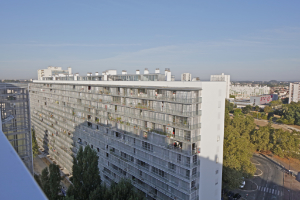 The project consists in the transformation of 3 social housing’s buildings of 530 dwellings. Built in the early 60’s, they needed a renovation after their demolition has been ruled out. The transformation of the dwellings full occupied, starts from the interior, to give them new qualities: more space, more light, more view, and upgrade the facilities.
The transformation gives to all dwellings new qualities of space and living, by inventorying very precisely the existing qualities that should be preserved, and what is missing that must be supplemented.
The addition of large winter gardens and balconies in extension of the existing give the opportunity, for each apartment, to enjoy more space, more natural light, more mobility of use and more views.
The existing small windows are replaced by large glazed sliding doors opening onto the winter garden. The technical facilities are upgraded: bathrooms electrical installation, the two former elevators in every staircase are replaced by a bigger one and supplemented by a new elevator.
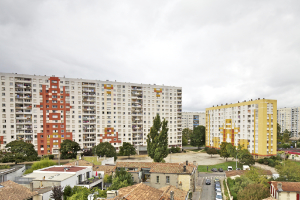 New access halls are done and the gardens in front of the building are improved. All the families stayed in their dwelling during the construction works. No increase of rent after the transformation. While the high-rise buildings for luxury housing are now designated as examples of ecological housing, the G, H and I buildings offer the opportunity to reach these qualities immediately, in a generous, economic and sustainable way. Due to the proposal of transformation with all inhabitants inside, the project excludes interventions on the existing structure, stairs or floors, and proceeds by additions and extensions, large enough to be fully used. Inside the flats, only refurbishment of facilities or finishes has been done. The extensions of 3,80m deep widen the space of use and the mobility through large glazed sliding doors connecting every room to the winter garden, offering, as in a house, a pleasant private semi outdoor space.
The energetic performance of the building envelope is highly improved by the addition of winter gardens which act as passive solar collectors.
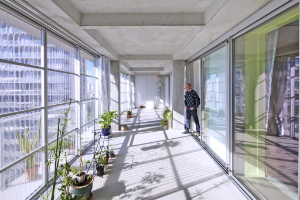 The work on economy allows to concentrate the budget on the extensions, the key point to improve in a significant and sustainable way the dwellings quality. The overall cost of transformation respects the budget, based on the usual cost for a basic renovation of facades, insulations, and facilities.
In order to reduce the duration of the works, the construction uses prefabricated modules, fast built like scaffolding in front of the building. Precasted slabs and columns are transported to the site and lifted into position by a crane to form a freestanding structure. Concrete poured in place was used only for foundations.
Along the added structure, the original windows are removed in a specific intervention to take care of asbestos-contaminated seals. Concrete window sills are removed to open from floor-to-ceiling, and create double-glazed sliding doors. Thermal curtains behind the glass provide extra insulation to the heated interiors.
On the other side, a lightweight façade of transparent, corrugated polycarbonate panels and glass in aluminium frames is assembled and equipped with reflective solar curtains. Glazed hand railings run along the balconies.
A proper planning and scheduling of the construction site allowed to achieve the transformation in just 12-16 days per apartment: half day for laying the concrete slab, 2 days for adapting the old façade, 2 days for placing the new façade, and 8-12 days for renovating the interiors. |
|
 |
 |
 |
|
 |
|
| . |
 |
|
 |
|
 |
 |
 |
 |
 |
 |
 |
POINTS OF VIEW |
 |
|
|
 |
|
 |
 |
 |
| |
 |
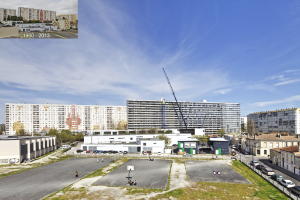 Lacaton & Vassal architectes Lacaton & Vassal architectesFrédéric Druot Architecture
Christophe Hutin Architecture:
“The project consists in the transformation of 3 social housing’s buildings of 530 dwellings. Built in the early 60’s, they needed a renovation after their demolition has been ruled out. The transformation of the dwellings full occupied, starts from the interior, through the addition of extended wintergardens and balconies, to give to every dwelling new qualities: more space, more light, more view, and upgrade the facilities.” |
|
 |
 |
 |
 |
ECO-SUSTAINABILITY |
 |
|
|
 |
|
 |
 |
 |
|
|
 |
The energetic performance of the building envelope is highly improved by the addition of winter gardens which act as passive solar collectors.
|
|
 |
 |
 |
 |
 |
 |
 |
LOCATION |
 |
|
|
 |
|
 |
 |
 |

|
 |

|
Continent |
|
 |
|
Nation |
|
 |
|
Region |
|
 |
|
District |
|
 |
|
Arrondissement |
|
 |
|
Town |
|
 |
|
Neighborhoods |
|
 |
|
Address |
|
 |
|
|
|
 |
|
 |
 |
 |
 |
MAP |
 |
|
|
 |
|
 |
 |
 |
| |
 |
|
 |
 |
 |
 |
|
TYPOLOGY |
 |
|
|
 |
|
 |
 |
 |
|
|
 |
ARCHITECTURE | Residential buildings
Multiple dwelling
Operations on existing buildings
Renovation, rehabilitation and restructuring
Extension, superelevation
| |
 |
 |
 |
 |
CHRONOLOGY |
 |
|
|
 |
|
 |
 |
 |
Project |
 |
|
 |
| 
 |
2011 - 2014
project winner of competition
|
|
Realisation |
 |
|
 |
| 
 |
2014 - 2017 |
|
 |
 |
 |
 |
AWARDS |
 |
|
|
 |
|
 |
 |
 |
| 2019 |
 |
|
 |
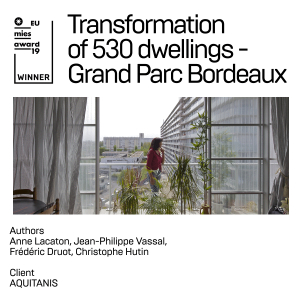
European Union Prize for Contemporary Architecture
Mies van der Rohe Award
The Jury valued that the project challenges the existing European housing stock from the post war period, using minimum means to achieve a maximum effect. Instead of demolishing, which involves the use of an important amount of energy, in this case the client understood and supported the advantages of transforming the existing three buildings. This has changed people’s lives for the better without underestimating their previous lives, filling the new volume with poetry because it works with the basis that people understand space and in consequence, they use it in very different ways.
At a moment in which the commissions for new social housing blocks ask for a reduction of the surface of flats, here the volume is increased, offering dignity and giving more value to the individual and to the collective. The ensemble becomes an optimistic opportunity for social housing and modernity, being generous and also changing architecture and the possibilities of architecture. The architects show a very high acknowledgement of who – a mix of inhabitants – and what – the results from previous research on transformation – they are working with. This results in a refined way of working with people, space and materials although the improvement in the collective could have been stronger if the opportunities in the relationship with the street would have been different. |
|
 |
 |
 |
 |
 |
 |
 |
BIBILIOGRAPHIC REFERENCES |
 |
|
|
 |
|
 |
 |
 |
|
 |
| Emmanuelle Borne, "Anne Lacaton: «Nous cherchons toujours à dilater l'espace / We always try to expand space»", L'Architecture d'Aujourd'hui 424, mai/may 2018, "Dossier" pp. 46-51 |
|
|
| "Elogio del ahorro / 530 dwellings, Bordeaux (France)", Arquitectura Viva 202, 3/2018 [Vivienda rehabilitada. Hacia una Europa sostenibile], pp. 16-21 |
|
|
| Marco Biagi, "Trasformazione di 530 alloggi negli edifici G, H e I del quartiere Grand Parc, Bordeaux, Francia / Transformation of 530 social housing units at the G, H and I estates at the Cité du Grand Parc, Bordeaux, France", Casabella 878, ottobre/october 2017, pp. 48-56 |
|
|
| Michael Koller, "Besser Wohnen. Umbau von 530 Wohnungen, Bordeaux/FR", D BZ Deutsche BauZeitschrift 5/2017, "Architektur" pp. 34-41 |
|
|
Peter Smisek, "Anne Lacaton: 'inhabitants are actually very attached to their homes and don't see them as mistakes'", Icon 164, february 2017, pp. 100-106
"It is very important to make a building in which users find freedom", Icon 164, february 2017, pp. 103-106 (100-106) |
|
|
| Lacaton & Vassal (text), Philippe Ruault (photo), "Urbanismo de grano fino. Las viviendas expandidas de Lacaton & Vassal", Plot diciembre 2016 [Super urbano], pp. 46-59 |
|
|
| Karine Dana (text), Philippe Ruault (photo), "Die Cité du Grand Parc in Bordeaux", Bauwelt 39-2016, 25 november 2016, "Thema" pp. 38-47 |
|
|
| Olivier Wainwright, "Modèle du genre / Lessons in housing", L'Architecture d'Aujourd'hui 412, mai/may 2016 [France], pp. 54-57 |
|
|
| Christophe Catsaros, "L'extension du domaine habitable", Tracés 05-06, 11 mars 2016, "Architecture" pp. 28-30 |
|
|
| "Jardins d'hiver et balcons en extension", Moniteur Architecture AMC 242, mai/may 2015, pp. 82-83 |
|
 |
 |
 |
 |
 |
 |
 |
CLIENT |
 |
|
|
 |
|
 |
 |
 |
| |
 |
| Aquitanis O.P.H. de la communauté Urbaine de Bordeaux (CUB) |
|
 |
 |
 |
 |
AMOUNT |
 |
|
|
 |
|
 |
 |
 |
| |
 |
|
 |
 |
 |
 |
DIMENSIONAL
DATA |
 |
|
|
 |
|
 |
 |
 |
| Surface |
 |
|
 |
total sq.m. 23,745
usable sq.m. 81,000
|
|
| Consistence |
 |
|
 |
530 transformed dwellings
8 new dwellings |
|
 |
 |
 |
 |
STRUCTURES |
 |
|
|
 |
|
 |
 |
 |
| |
 |
|
 |
 |
 |
 |
LANDSCAPE DESIGN |
 |
|
|
 |
|
 |
 |
 |
| |
 |
|
 |
 |
 |
 |
STAFF |
 |
|
|
 |
|
 |
 |
 |
Project  |
 |
Lacaton & Vassal architectes
Frédéric Druot Architecture
Christophe Hutin Architecture |
|
|
 |
|
|
 |
|
Construction management |
 |
|
Structural consultant |
 |
SECOTRAP ingénierie (concrete structure)
CESMA (metalic structure) |
|
Mechanical engineer |
 |
|
Systems |
 |
|
Quantity surveyor |
 |
|
 |
 |
 |
 |
CREDITS |
 |
|
|
 |
|
 |
 |
 |
| |
 |
Photos © Philippe Ruault
Text edited by Fundació Mies van der Rohe
Courtesy of Fundació Mies van der Rohe
|
|
 |
  |
 |
|
|